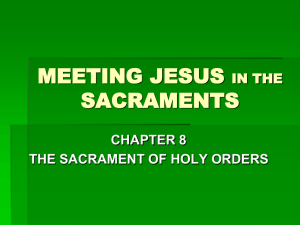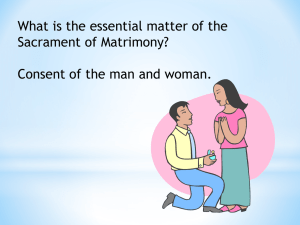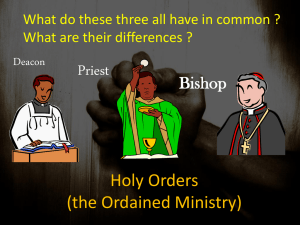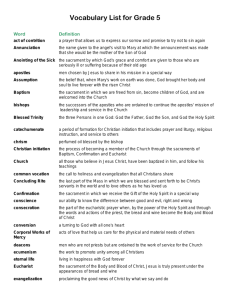THE SACRAMENT OF HOLY ORDERS
advertisement
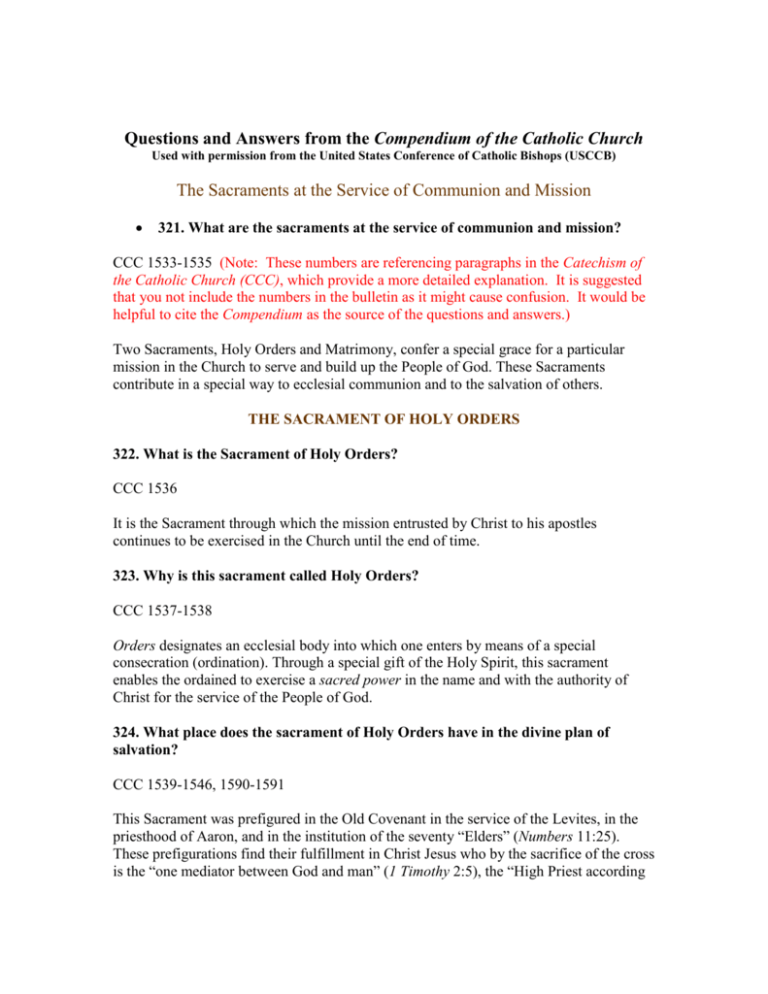
Questions and Answers from the Compendium of the Catholic Church Used with permission from the United States Conference of Catholic Bishops (USCCB) The Sacraments at the Service of Communion and Mission 321. What are the sacraments at the service of communion and mission? CCC 1533-1535 (Note: These numbers are referencing paragraphs in the Catechism of the Catholic Church (CCC), which provide a more detailed explanation. It is suggested that you not include the numbers in the bulletin as it might cause confusion. It would be helpful to cite the Compendium as the source of the questions and answers.) Two Sacraments, Holy Orders and Matrimony, confer a special grace for a particular mission in the Church to serve and build up the People of God. These Sacraments contribute in a special way to ecclesial communion and to the salvation of others. THE SACRAMENT OF HOLY ORDERS 322. What is the Sacrament of Holy Orders? CCC 1536 It is the Sacrament through which the mission entrusted by Christ to his apostles continues to be exercised in the Church until the end of time. 323. Why is this sacrament called Holy Orders? CCC 1537-1538 Orders designates an ecclesial body into which one enters by means of a special consecration (ordination). Through a special gift of the Holy Spirit, this sacrament enables the ordained to exercise a sacred power in the name and with the authority of Christ for the service of the People of God. 324. What place does the sacrament of Holy Orders have in the divine plan of salvation? CCC 1539-1546, 1590-1591 This Sacrament was prefigured in the Old Covenant in the service of the Levites, in the priesthood of Aaron, and in the institution of the seventy “Elders” (Numbers 11:25). These prefigurations find their fulfillment in Christ Jesus who by the sacrifice of the cross is the “one mediator between God and man” (1 Timothy 2:5), the “High Priest according to the order of Melchizedek” (Hebrews 5:10). The one priesthood of Christ is made present in the ministerial priesthood. “Only Christ is the true priest, the others being only his ministers.” (Saint Thomas Aquinas) 325. What are the degrees that make up the sacrament of Holy Orders? CCC 1554, 1593 The Sacrament of Holy Orders is composed of three degrees which are irreplaceable for the organic structure of the Church: the episcopate, the presbyterate and the diaconate. 326. What is the effect of episcopal ordination? CCC 1557-1558 Episcopal ordination confers the fullness of the Sacrament of Holy Orders. It makes the bishop a legitimate successor of the apostles and integrates him into the episcopal college to share with the Pope and the other bishops care for all the churches. It confers on him the offices of teaching, sanctifying, and ruling. 327. What is the office confided to a Bishop in a particular Church? CCC 1560-1561 The bishop to whom the care of a particular Church is entrusted is the visible head and foundation of unity for that Church. For the sake of that Church, as vicar of Christ, he fulfills the office of shepherd and is assisted by his own priests and deacons. 328. What is the effect of ordination to the priesthood? CCC 1562-1567, 1595 The anointing of the Spirit seals the priest with an indelible, spiritual character that configures him to Christ the priest and enables him to act in the name of Christ the Head. As a co-worker of the order of bishops he is consecrated to preach the Gospel, to celebrate divine worship, especially the Eucharist from which his ministry draws its strength, and to be a shepherd of the faithful. 329. How does a priest carry out his proper ministry? CCC 1568 A priest, although ordained for a universal mission, exercises his ministry in a particular Church. This ministry is pursued in sacramental brotherhood with other priests who form the “presbyterate”. In communion with the bishop, and depending upon him, they bear responsibility for the particular Church. 330. What is the effect of the ordination to the diaconate? CCC 1569-1571, 1596 The deacon, configured to Christ the servant of all, is ordained for service to the Church. He carries out this service under the authority of his proper bishop by the ministry of the Word, of divine worship, of pastoral care and of charity. 331. How is the sacrament of Holy Orders celebrated? CCC 1572-1574, 1597 The sacrament of Holy Orders is conferred, in each of its three degrees, by means of the imposition of hands on the head of the ordinand by the Bishop who pronounces the solemn prayer of consecration. With this prayer he asks God on behalf of the ordinand for the special outpouring of the Holy Spirit and for the gifts of the Spirit proper to the ministry to which he is being ordained. 332. Who can confer this sacrament? CCC 1575-1576, 1600 Only validly ordained bishops, as successors of the apostles, can confer the Sacrament of Holy Orders. 333. Who can receive this sacrament? CCC 1577-1578, 1598 This sacrament can only be validly received by a baptized man. The Church recognizes herself as bound by this choice made by the Lord Himself. No one can demand to receive the sacrament of Holy Orders, but must be judged suitable for the ministry by the authorities of the Church. 334. Is it necessary to be celibate to receive the sacrament of Holy Orders? CCC 1579-1580, 1599 It is always necessary to be celibate for the episcopacy. For the priesthood in the Latin Church men who are practicing Catholics and celibate are chosen, men who intend to continue to live a celibate life “for the kingdom of heaven” (Matthew 19:12). In the Eastern Churches marriage is not permitted after one has been ordained. Married men can be ordained to the permanent diaconate. 335. What are the effects of the Sacrament of Holy Orders? CCC 1581-1589 This sacrament yields a special outpouring of the Holy Spirit which configures the recipient to Christ in his triple office as Priest, Prophet, and King, according to the respective degrees of the Sacrament. Ordination confers an indelible spiritual character and therefore cannot be repeated or conferred for a limited time. 336. With what authority is the priestly ministry exercised? CCC 1547-1553, 1592 Ordained priests in the exercise of their sacred ministry speak and act not on their own authority, nor even by mandate or delegation of the community, but rather in the Person of Christ the Head and in the name of the Church. Therefore, the ministerial priesthood differs essentially and not just in degree from the priesthood common to all the faithful for whose service Christ instituted it.
